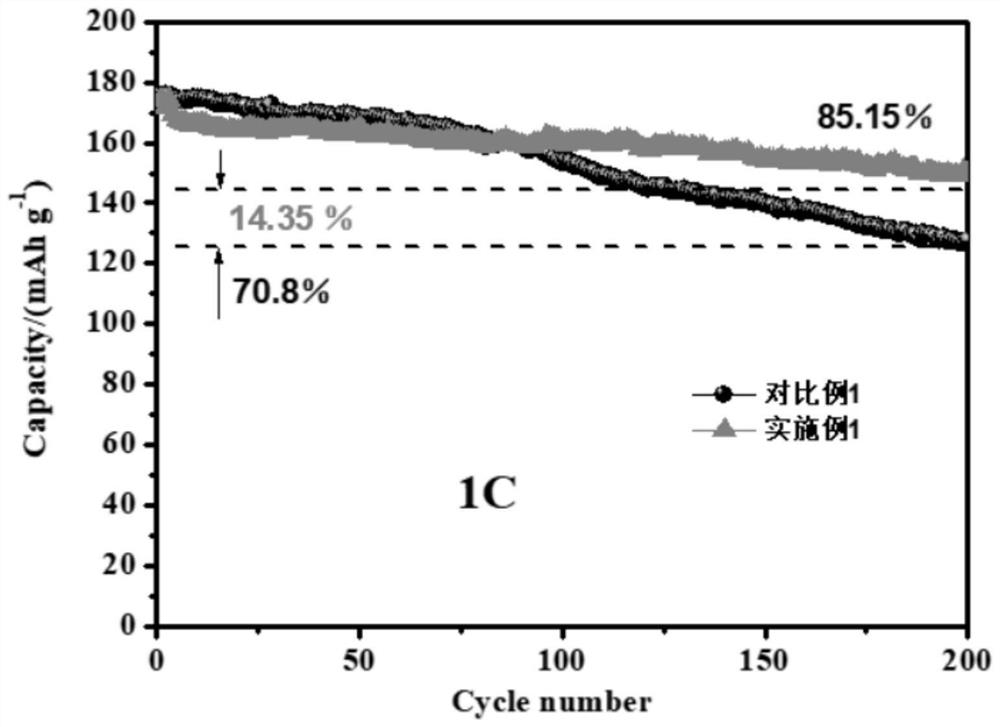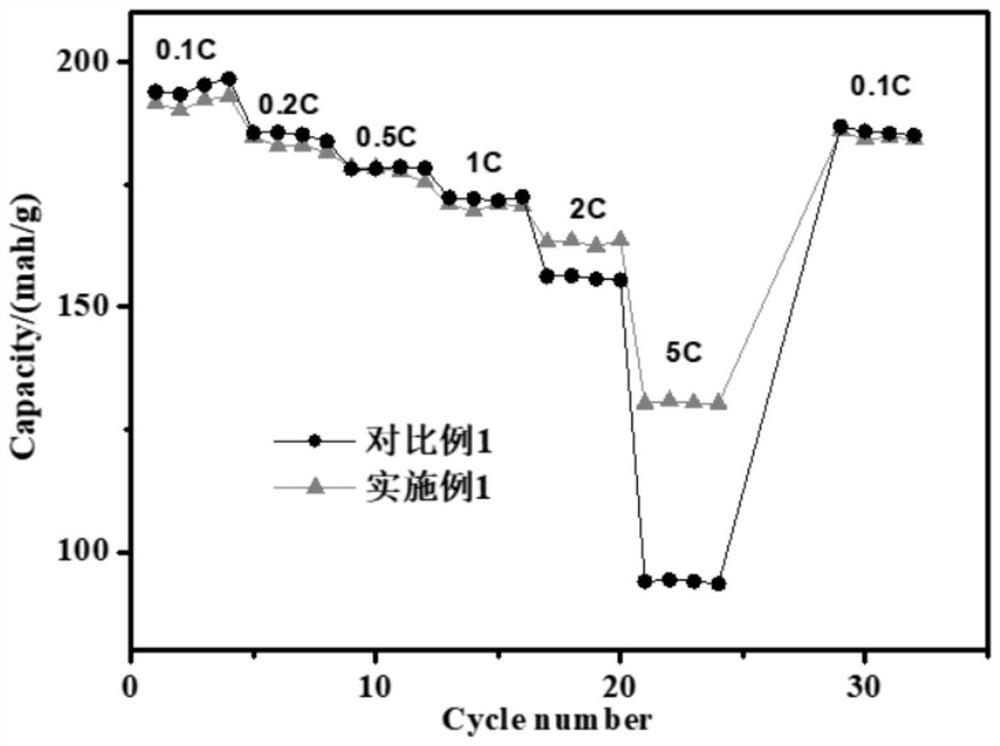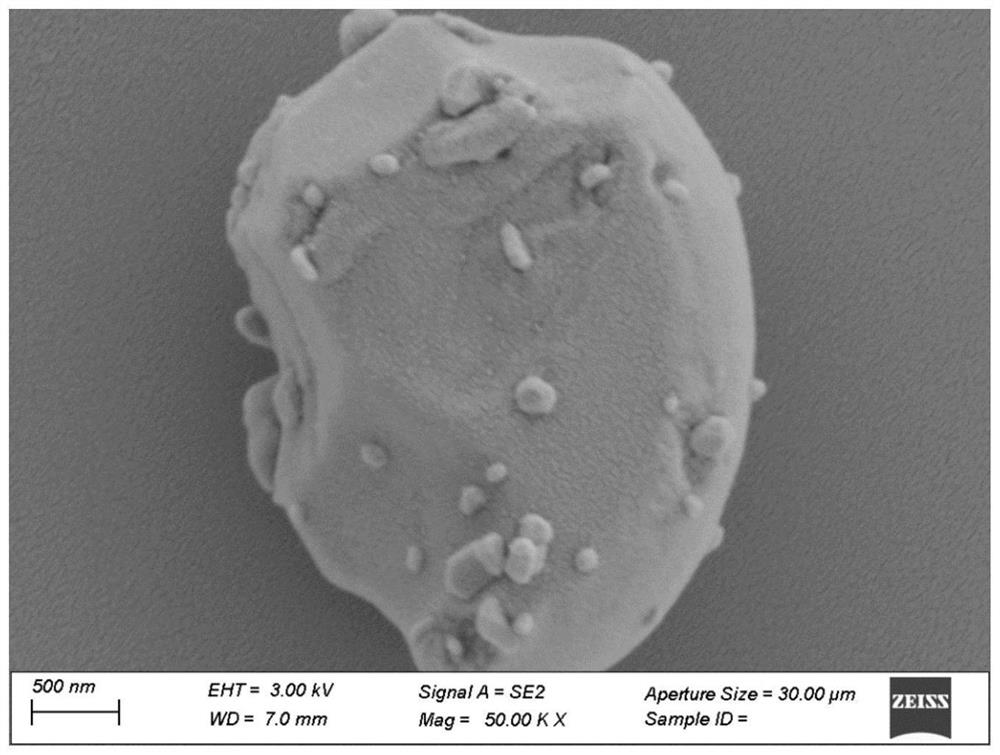Preparation method of in-situ coated single-crystal high-nickel ternary positive electrode material
A cathode material and in-situ coating technology, which is applied in the field of preparation of single-crystal high-nickel ternary cathode materials that are sintered at low temperature and achieve in-situ coating, can solve problems such as lithium loss, reduction of electrochemical performance of cathode materials, and mixed arrangement. , to achieve the effect of controlling particle size
- Summary
- Abstract
- Description
- Claims
- Application Information
AI Technical Summary
Problems solved by technology
Method used
Image
Examples
Embodiment 1
[0038] (1) Ni 0.8 co 0.1 mn 0.1 (OH) 2 Grinding with lithium oxalate in a molar ratio of 1:1.08 to obtain mixed powder a;
[0039] (2) Mix powder b of vanadium oxide and molybdenum oxide with mixed powder a, grind and mix uniformly to obtain mixed powder c, wherein the mass fraction of mixed powder b in mixed powder c is 4%; Vanadium oxide and molybdenum oxide are mixed according to the molar ratio of metal ion vanadium and metal ion molybdenum of 1:1;
[0040] (3) Then put the mixed powder c in a microwave sintering furnace, raise the temperature up to 160°C at a rate of 5°C / min and keep it for 2 hours under the condition of oxygen flow, and then raise it to 450°C at a rate of 5°C / min and hold it for 5 hours , and then raised to 880°C at a rate of 1°C / min and held for 16 hours, and cooled with the furnace to obtain a solid block material;
[0041] (4) After crushing and grinding the solid block material, mix it with deionized water at a mass ratio of 1:10, ultrasonically...
Embodiment 2
[0045] (1) Ni 0.8 co 0.1 mn 0.1 (OH) 2 Grinding with lithium oxalate in a molar ratio of 1:1.08 to obtain mixed powder a;
[0046] (2) Mix powder b of vanadium oxide and molybdenum oxide with mixed powder a, grind and mix uniformly to obtain mixed powder c, wherein the mass fraction of mixed powder b in mixed powder c is 6%; Vanadium oxide and molybdenum oxide are mixed according to the molar ratio of metal ion vanadium and metal ion molybdenum of 1:1;
[0047] (3) Then put the mixed powder c in a microwave sintering furnace, raise the temperature up to 160°C at a rate of 5°C / min and keep it for 2 hours under the condition of oxygen flow, and then raise it to 450°C at a rate of 5°C / min and hold it for 5 hours , and then raised to 880°C at a rate of 1°C / min and held for 16 hours, and cooled with the furnace to obtain a solid block material;
[0048] (4) After crushing and grinding the solid block material, mix it with deionized water at a mass ratio of 1:10, ultrasonically...
Embodiment 3
[0052] (1) Ni 0.8 co 0.1 mn 0.1 (OH) 2 Grinding with lithium oxalate in a molar ratio of 1:1.08 to obtain mixed powder a;
[0053] (2) Mix powder b of vanadium oxide and molybdenum oxide with mixed powder a, grind and mix uniformly to obtain mixed powder c, wherein the mass fraction of mixed powder b in mixed powder c is 8%; Vanadium oxide and molybdenum oxide are mixed according to the molar ratio of metal ion vanadium and metal ion molybdenum of 1:1;
[0054] (3) Then put the mixed powder c in a microwave sintering furnace, raise the temperature up to 160°C at a rate of 5°C / min and keep it for 2 hours under the condition of oxygen flow, and then raise it to 450°C at a rate of 5°C / min and hold it for 5 hours , and then raised to 880°C at a rate of 1°C / min and held for 16 hours, and cooled with the furnace to obtain a solid block material;
[0055] (4) After crushing and grinding the solid block material, mix it with deionized water at a mass ratio of 1:10, ultrasonically...
PUM
| Property | Measurement | Unit |
|---|---|---|
| Discharge capacity | aaaaa | aaaaa |
| Discharge capacity | aaaaa | aaaaa |
| Discharge capacity | aaaaa | aaaaa |
Abstract
Description
Claims
Application Information
 Login to View More
Login to View More - R&D
- Intellectual Property
- Life Sciences
- Materials
- Tech Scout
- Unparalleled Data Quality
- Higher Quality Content
- 60% Fewer Hallucinations
Browse by: Latest US Patents, China's latest patents, Technical Efficacy Thesaurus, Application Domain, Technology Topic, Popular Technical Reports.
© 2025 PatSnap. All rights reserved.Legal|Privacy policy|Modern Slavery Act Transparency Statement|Sitemap|About US| Contact US: help@patsnap.com



